Search results for 'Chapter 5: Apply Your Knowledge – Adding Fields, Using Input Mask and Querying Dates (Pages 327 - 328) Use the Babbage CPA'
Maximum words count is 10. In your search query was cut next part: Mask and Querying Dates (Pages 327 - 328) Use the Babbage CPA.
-

ITS320 Module 1 Option 1 Create a Python Application that outputs mouse
Regular Price: $10.00
Special Price $8.00
ITS320 Module 1 Option 1 Create a Python Application that outputs mouse
Option #1: Create a Python Application
Write a Python Program that outputs this mouse:
(\-.
/ _`>
_) / _)=
( / _/
`-.__(___)_
Assignment Instructions
1. Install Python3 on your computer if you do not have it already installed it. You can download it from https://www.python.org/downloads/release/python-362/.
2. Make sure you check the box to include the Python executable in your environment path.
3. Edit your Python program using your choice of editor such as Notepad, Notepad++, or Idle. Idle is a simple Python interactive development environment that installed with your Python package.
4. Save your Python code using the file name ITS320_CTA1_Option1.py.
5. Execute your Python code in command prompt as python ITS320_CTA1_Option1.Assignment Deliverables
Learn More
• Submit the text file named ITS320_CTA1_Option1.py that contains your Python code into the Module 1 drop box -

ITS320 Module 1 Option 2 Create a Python Application that read two integers and print two lines
Regular Price: $10.00
Special Price $8.00
ITS320 Module 1 Option 2 Create a Python Application that read two integers and print two lines
Option #2: Create a Python Application
Read two integers and print two lines. The first line should contain integer division, //, the second line should contain float division, /, and the third line should contain modulo division, %. You do not need to perform any rounding or formatting operations.
Input Format The first line contains the first integer. The second line contains the second integer.
Output Format Print the three lines as described above.Sample Input
4
3Sample Output
1
1.3333333333333333
1Assignment Instructions
1. Install Python3 on your computer if you don’t have it already installed. Make sure you check the box to include the Python executable in your environment path.
2. Edit your Python program using your choice of editor such as Notepad, Notepad++, or Idle. Idle is a simple Python interactive development environment that installed with your Python package.
3. Save your Python code in a file name ITS320_CTA1_Option2.py.
4. Execute your Python code in command prompt as python ITS320_CTA1_Option2.Assignment Deliverables
Learn More
Submit the text file named ITS320_CTA1_Option2.py that contains your Python code into the Module 1 drop box. -
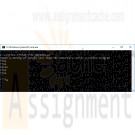
ITS320 Module 2 Option 1 Creating a Python Application for string validation
Regular Price: $10.00
Special Price $8.00
ITS320 Module 2 Option 1 Creating a Python Application for string validation
Option #1: Creating a Python Application
Python has built-in string validation methods for basic data. It can check if a string is composed of alphabetical characters, alphanumeric characters, digits, etc.
str.isalnum() This method checks if all the characters of a string are alphanumeric (a-z, A-Z and 0-9).
>>> print 'ab123'.isalnum()
True
>>> print 'ab123#'.isalnum()
False
str.isalpha() This method checks if all the characters of a string are alphabetical (a-z and A-Z).
>>> print 'abcD'.isalpha()
True
>>> print 'abcd1'.isalpha()
False
str.isdigit() This method checks if all the characters of a string are digits (0-9).
>>> print '1234'.isdigit()
True
>>> print '123edsd'.isdigit()
False
str.islower() This method checks if all the characters of a string are lowercase characters (a-z).
>>> print 'abcd123#'.islower()
True
>>> print 'Abcd123#'.islower()
FalseSAMPLE
str.isupper() This method checks if all the characters of a string are uppercase characters (A-Z).
>>> print 'ABCD123#'.isupper()
True
>>> print 'Abcd123#'.isupper()
FalseAssignment Instructions:
Write a Python program that performs the following tasks:
1. Read from the console an arbitrary string S of length less than 50 characters.
2. In the first output line, print True if S has any alphanumeric characters. Otherwise, print False.
3. In the second line, print True if S has any alphabetical characters. Otherwise, print False.
4. In the third line, print True if S has any digits. Otherwise, print False.
5. In the fourth line, print True if S has any lowercase characters. Otherwise, print False.
6. In the fifth line, print True if S has any uppercase characters. Otherwise, print False.
7. Develop Python code that implements the program requirements.Assignment Deliverables:
Learn More
• Submit a text file containing your Python code into the Module 2 drop box. Name your file ITS320_CTA2_Option1.py -
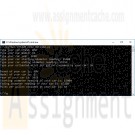
ITS320 Module 2 Option 2 Creating a Python Application using dictionary
Regular Price: $10.00
Special Price $8.00
ITS320 Module 2 Option 2 Creating a Python Application using dictionary
Option #2: Creating a Python Application
Assignment Instructions
Develop a Python application that incorporates using appropriate data types and provides program output in a logical manner. Your program should prompt a user to enter a car brand, model, year, starting odometer reading, an ending odometer reading, and the estimated miles per gallon consumed by the vehicle. Store your data in a dictionary and print out the contents of the dictionary.Assignment Submission Instructions:
Learn More
Submit a text file containing your Python code into the Module 2 drop box. Name your file ITS320_CTA2_Option2.py. -
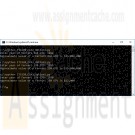
ITS320 Module 3 Option 1 Creating a Program to Calculate the Value of a Ferrari
Regular Price: $10.00
Special Price $8.00
ITS320 Module 3 Option 1 Creating a Program to Calculate the Value of a Ferrari
Option #1: Creating a Program to Calculate the Value of a Ferrari
Assignment Instructions
Implement a program that reads in a year and outputs the approximate value of a Ferrari 250 GTO in that year. Use the following table that describes the estimated value of a GTO at different times since 1962.
Year Value
1962-1964 $18,500
1965-1968 $6,000
1969-1971 $12,000
1972-1975 $48,000
1976-1980 $200,000
1981-1985 $650,000
1986-2012 $35,000,000
2013-2014 $52,000,000
(Source: Programming in Python 3 with Zylabs, Chapter 4, Participation Activity 4.3.5)Assignment Submission Instructions
Learn More
Submit a text file containing your Python code into the Module 3 drop box. Name your file ITS320_CTA3_Option1.py. -
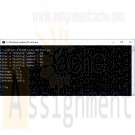
ITS320 Module 4 Option 1 Repetition Control Structure – Five Floating Point Numbers
Regular Price: $10.00
Special Price $8.00
ITS320 Module 4 Option 1 Repetition Control Structure – Five Floating Point Numbers
Option #1: Repetition Control Structure – Five Floating Point Numbers
Assignment Instructions
Write a program that utilizes a loop to read a set of five floating-point values from user input. Ask the user to enter the values, then print the following data:
• Total
• Average
• Maximum
• Minimum
• Interest at 20% for each original value entered by the user.
• Use the formula: Interest_Value = Original_value + Original_value*0.2Assignment Submission Instructions
Learn More
• Submit a text file containing your Python code into the Module 4 drop box. Name your file ITS320_CTA4_Option1.py. -
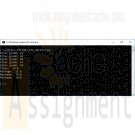
ITS320 Module 4 Option 2 Repetition Control Structure – Grade Statistics
Regular Price: $10.00
Special Price $8.00
ITS320 Module 4 Option 2 Repetition Control Structure – Grade Statistics
Option #2: Repetition Control Structure – Grade Statistics
Assignment Instructions
1. Write a program that will provide important statistics for the grades in a class. The program will utilize a loop to read five floating-point grades from user input.
2. Ask the user to enter the values, then print the following data:
• Average
• Maximum
• MinimumAssignment Submission Instructions
Learn More
• Submit a text file containing your Python code into the Module 4 drop box. Name your file ITS320_CTA4_Option2.py -
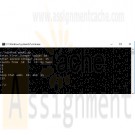
DAT 210 Week 2 Using Loops in Python
Regular Price: $12.00
Special Price $10.00
DAT 210 Week 2 Using Loops in Python
You recently graduated college and you are applying for a programming job that requires the understanding of loops in Python. The manager you are interviewing with has asked you to take an assessment to prove your programming knowledge. Below are the requirements for the programming skills test.
DAT 210 Week 2 Using Loops in Python
You recently graduated college and you are applying for a programming job that requires the understanding of loops in Python. The manager you are interviewing with has asked you to take an assessment to prove your programming knowledge. Below are the requirements for the programming skills test.
In Python, create a program that meets the following requirements:
• Take two integers from the user.
• Save the lower number as x.
• Save the largest integer as y.
• Write a loop that counts from x to y by twos.
• Print out the values of that loop using the Print function in Python.
• Write another loop that adds x and y, and saves the value as Z.
• Print out the values of Z using the Print function in Python.Provide the code and take a screenshot of the output, then paste the screenshot(s) into a Microsoft® Word document.
Review Chapters 6 and 11 of Python for Everyone if you have additional questions on creating a program in Python.
Submit your document.
In Python, create a program that meets the following requirements:
• Take two integers from the user.
• Save the lower number as x.
• Save the largest integer as y.
• Write a loop that counts from x to y by twos.
• Print out the values of that loop using the Print function in Python.
• Write another loop that adds x and y, and saves the value as Z.
• Print out the values of Z using the Print function in Python.
Provide the code and take a screenshot of the output, then paste the screenshot(s) into a Microsoft® Word document.
Review Chapters 6 and 11 of Python for Everyone if you have additional questions on creating a program in Python.
Submit your document.
Learn More -
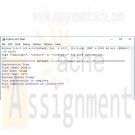
CIS115 Week 1 Lab Building a Registration Form and Pay Calculator in Python
Regular Price: $12.00
Special Price $10.00
CIS115 Week 1 Lab Building a Registration Form and Pay Calculator in Python
CIS115 Week 1 Lab Overview
Title of Lab: Building a Registration Form and Pay Calculator in Python
Summary – Part 1
Create a program that allows a student to complete a registration form and displays a completion message that includes the user's full name and a temporary password.Summary – Part 2
Create a program that calculates a user's weekly gross and take-home pay.Deliverables
• 2 source code Python files.
• A Word document containing both source code and the screen print of the program outputs.Lab Steps
Part 1 – Registration FormSample Output:
Registration Form
First Name: Eric
Last Name: Idle
Birth Year: 1934
Welcome Eric Idle!
Your Registration is complete.
Your temporary password is: Eric*1934Specifications:
• The user's full name consists of the user's first name, a space, and the user's last name.
• The temporary password consists of the user's first name, an asterisk (*), and the user's birth year.
• Assume the user will enter valid data.INPUT PROCESSING OUTPUT
first_name password=first_name + "*" + str(birth_year) password
last_name
birth_year
Part 2 – Pay CalculatorSample Output:
Pay Check Calculator
Hours Worked: 35
Hourly Pay Rate: 14.50
Gross Pay: 507.5
Tax Rate: 18
Tax Amount: 91.35
Take Home Pay: 416.15• The formula for calculating gross pay is:
o gross pay = hours worked * hourly rate
• The formula for calculating tax amount is:
o tax amount = gross pay * (tax rate / 100)
• The formula for calculating take home pay is:
o take home pay = gross pay - tax amount
• The tax rate should be 18%, but the program should store the tax rate in a variable so that you can easily change the tax rate later, just by changing the value that's stored in the variable.
• The program should accept decimal entries like 35.5 and 14.25.
• Assume the user will enter valid data.
• The program should round the results to a maximum of two decimal places.INPUT PROCESSING OUTPUT
Learn More
hours gross_pay = round(hours * pay_rate, 2) gross_pay
pay_rate tax_rate = 18 tax_rate
tax_amount = round(gross_pay * (tax_rate / 100), 2) tax_amount
take_home_pay = round(gross_pay - tax_amount, 2) take_home_pay -
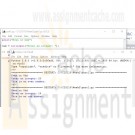
CIS115 Week 2 Lab Even or Odd and Grade Checker in Python
Regular Price: $12.00
Special Price $10.00
CIS115 Week 2 Lab Even or Odd and Grade Checker in Python
CIS115 Week 2 Lab Overview
Title of Lab: Even or Odd and Grade Checker in Python
Summary - Part 1
Create a program that checks whether a number is even or odd.Summary - Part 2
Create a program that checks one's letter grade.Deliverables
• 2 source code Python files.
• A Word document containing both source code and the screen print of the program outputs.Lab Steps
Part 1 - Even or OddSample Output:
Even or Odd
Enter an integer: 20
This is an even number.Specifications:
• Use the selection structure.
• Assume that the user will enter a valid integerPart 2 - Pay Calculator
Make sure to use the following criteria:
• 100 - 90: A
• 89 - 80: B
• 79 - 70: C
• 69 - 60: D
• 59 and below: FSample Output:
Grade Checker
Enter your grade: 88
You earned a B• Assume the user will enter valid data.
Learn More
• Selection structure needs to be used.




